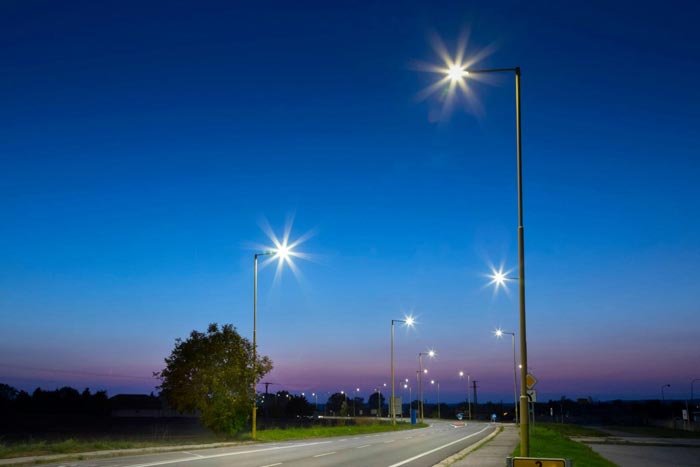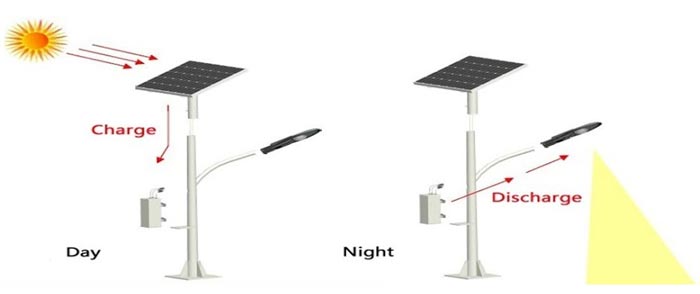As cities look for efficient, cost-effective, and environmentally friendly ways to light their streets, solar LED street lights are becoming increasingly common. These systems use sunlight as their primary energy source and LED lamps for illumination, creating a self-sufficient and low-maintenance lighting solution. More and more municipalities, private developers, and rural communities are installing solar LED street lights to reduce energy costs and improve lighting reliability.
So what makes these lights so practical and popular in today’s world? This article explores how solar LED street lights work, their key benefits, current applications, and the reasons they are a smart choice for urban and rural areas alike.

A solar LED street light is a stand-alone lighting system that uses solar energy to power LED bulbs. These systems are designed to operate independently of the power grid. Each unit typically includes the following components:
Solar panels: Mounted at the top of the pole, they absorb sunlight during the day and convert it into electricity.
Rechargeable batteries: Store the generated electricity for nighttime use.
LED lamp: Uses stored energy to provide efficient and bright illumination.
Charge controller: Regulates the flow of electricity between the solar panel, battery, and LED lamp, protecting the battery from overcharging or deep discharge.
Pole and mounting system: Designed to hold all the components securely and withstand harsh weather conditions.
This setup allows solar LED street lights to work without any external power supply or underground wiring.

Solar LED street lights follow a simple yet effective process:
During daylight hours, solar panels capture sunlight and convert it into electricity.
This electricity is stored in the battery through the charge controller.
At night or in low-light conditions, a light sensor activates the LED lamp, which draws energy from the battery.
Some models are equipped with motion sensors, which reduce the light's brightness when there is no movement nearby, further conserving energy.
All these components work together seamlessly to provide lighting throughout the night without the need for grid electricity.
LED lights consume significantly less energy than traditional bulbs like incandescent or fluorescent lights. Combined with solar power, the system becomes even more energy-efficient because it doesn’t rely on fossil fuels or utility electricity.
Although the initial cost of solar LED street lights may be higher than traditional street lights, the long-term savings are substantial. There are no electricity bills, and maintenance costs are low due to the durable nature of LEDs and the absence of wiring and external connections.
Solar LED street lights produce zero emissions during operation. They rely entirely on clean, renewable solar energy, reducing carbon footprints and helping cities meet their environmental goals.
Because they operate off-grid, these lights are ideal for remote or rural areas where extending power lines would be expensive or impractical. They also provide lighting during power outages, improving public safety.
Installing a solar LED street light is generally faster and simpler than setting up traditional lighting. There's no need for trenching, wiring, or heavy electrical work, which reduces labor and installation costs.
LEDs have a long operational life—typically over 50,000 hours—and the system as a whole requires minimal upkeep. Most systems can operate reliably for several years with only occasional cleaning or battery checks.
Proper street lighting improves road safety, reduces accidents, and discourages crime. Solar-powered systems can ensure lighting even in areas with unreliable grid connections, keeping neighborhoods and roads well-lit at all times.
Solar LED street lights are already in use across a wide range of environments and applications. Some common settings include:
City streets and highways: Many municipalities are installing solar lights to save money and reduce carbon emissions.
Parking lots and campuses: Universities, shopping centers, and office complexes use them for well-lit, low-cost parking areas.
Rural villages and small towns: Especially in countries with limited infrastructure, solar LED lights provide essential lighting in areas without reliable electricity.
Public parks and recreational areas: These lights are ideal for paths, picnic areas, and sports fields.
Industrial zones and construction sites: Temporary solar lighting can be quickly deployed and relocated as needed.
These lights are also increasingly common in disaster recovery zones or refugee camps, where rapid deployment and independent operation are crucial.
The reliability of solar LED street lights comes from the combination of proven technologies:
Solar panels today are highly efficient and can generate energy even on cloudy days.
Lithium-ion batteries or advanced gel batteries store power effectively and offer long lifespans.
LEDs are solid-state devices, meaning they have no moving parts and are resistant to vibration, impact, and temperature changes.
Smart controllers can monitor system performance, adjust brightness, and send alerts in case of malfunction, improving dependability.
Together, these elements ensure the system works reliably day after day, regardless of location or season.
While solar LED street lights offer many advantages, they also come with a few limitations:
Initial cost: The upfront price is typically higher than that of conventional lighting.
Sunlight dependency: Their performance is linked to sun exposure, which may vary depending on climate and geography.
Battery lifespan: Batteries may need to be replaced after several years, which adds to long-term costs.
Vandalism and theft: In some regions, the components (especially solar panels) may be at risk if not securely installed or monitored.
However, these challenges can often be addressed with proper planning, quality components, and secure installation.
The shift to solar LED street lighting is not just a trend—it’s a response to practical, economic, and environmental needs. Cities and communities are under pressure to:
Reduce public utility expenses
Lower greenhouse gas emissions
Expand infrastructure quickly and affordably
Provide reliable lighting in underserved areas
Solar LED street lights meet all these needs, offering a technology that works right now, without requiring major policy changes or infrastructure overhauls.
Solar LED street lights represent an effective solution for public lighting needs in both urban and rural settings. Their independence from the power grid, low maintenance requirements, and environmental benefits make them a practical choice for municipalities, businesses, and communities. As the world continues to adopt cleaner and smarter energy solutions, solar LED street lights stand out as a proven, efficient option that’s already transforming how streets are lit—one pole at a time.
FAQs
A solar LED street light is an independent lighting system that uses solar panels to convert sunlight into electricity, stores the power in a battery, and uses it to power LED lamps at night.
Yes, modern solar panels can still generate electricity under cloudy conditions, and the battery stores enough energy to power the lights for multiple nights, depending on the model.
The LED lights typically last over 50,000 hours, while the solar panels can last 20–25 years. Batteries usually need replacement every 3–7 years, depending on usage and type.
While the initial cost is higher than traditional lights, there are no electricity bills and minimal maintenance costs, resulting in lower total expenses over time.
Yes, solar LED street lights are ideal for remote areas because they don’t rely on external electricity. They are widely used in rural communities, parks, and off-grid roads.
Our hours
Mon 11/21 - Wed 11/23: 9 AM - 8 PM
Thu 11/24: closed - Happy Thanksgiving!
Fri 11/25: 8 AM - 10 PM
Sat 11/26 - Sun 11/27: 10 AM - 9 PM
(all hours are Eastern Time)